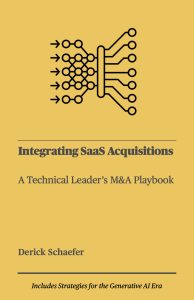Integrating SaaS Acquisitions
A modern playbook for business and technical leaders to plan and execute M&A-driven integrations, maximizing value for their organization, customers, and partners in the newly combined entity.
Print & eBook available on Apple, Amazon, and Barnes & Nobel.

Why this business leadership book matters?
Business combinations have a long-standing history, deeply embedded in traditional practices. However, a couple of decades ago, a new business segment emerged, delivering software solutions as internet-based services. The primary value of these businesses shifted from tangible assets to something digital—built on complex logic, terabytes of data, and systems serving thousands of businesses and millions of end users. This transformation coincides with exponentially growing demands for data privacy and digital security, all while mergers and acquisitions—driven increasingly by private equity firms—occur with greater frequency. Add the emergence of generative artificial intelligence to the equation, and the need for a book to demystify integrating one or more companies in this evolving landscape becomes undeniable.
What’s inside?
Integrating SaaS Acquisitions is the first strategic leadership book designed specifically to help software-as-a-service (SaaS) leadership teams navigate the complexities of integration acquisitions as part of their growth strategy. The book equips readers with the following essential insights:
For more information, visit a recap of the major sections and review the table of contents.